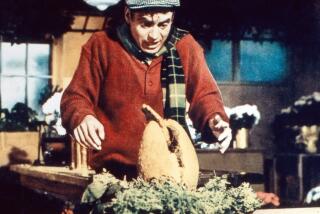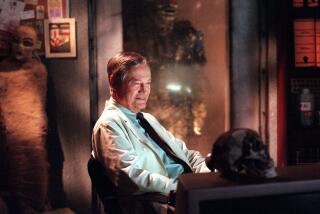Sure, He Flew the Wrong Way, but Everyone Loved It
- Share via
During this coming week, 52 years ago, a longtime Orange Countian named Douglas Corrigan pushed the Great Depression and the events leading up to World War II off the front pages of newspapers when he pulled off a stunt so daring that he caught the fancy and admiration of people all over the world. It was the kind of colossal nose-thumb at authority that ordinary folks applaud vicariously, and we enjoyed Doug Corrigan immensely for several months at a very difficult time in human history.
Corrigan was one of those kids who tinkered with everything that had moving parts. He was born in Texas and grew up in Los Angeles tinkering, and when he went to work as an aircraft mechanic in his late teens, his single-minded mission in life was to save enough money to buy his own plane. That ambition got a considerable shot in the arm when--as described in Vi Smith’s “From Jennies to Jets”--the 22-year-old Corrigan pulled the chocks on Charles Lindbergh’s “Spirit of St. Louis” on its flight from San Diego to New York before Lindbergh’s pioneering solo flight across the Atlantic on May 21, 1927.
It took Corrigan eight years after that to perfect his own flying skills and to save $310 to pay for a 1929 Curtis Robin monoplane that one of his buddies described as a “crate.” Corrigan needed 13 days to fly it back to California from New York, landing in cow pastures to patch it up sufficiently to take off the next morning. Over the next three years, he pulled out the 90-horsepower engine and installed a new one twice as powerful that he created out of the parts of two old Wright engines that he picked up for a song. During this period, a close friend--according to a 1938 story in The Times--described Corrigan as a “Depression aviator who flies by the seat of his trousers and puts every dime he gets back into his plane.”
Even so, it was still a “crate”--or at least that’s the way the Department of Commerce, which approved such things then, reacted when Corrigan requested permission to fly the Atlantic solo, a feat that had been accomplished only a handful of times since Lindbergh’s flight. And never in a secondhand, home-made crate like Corrigan’s. He tried to change the official position by flying his plane nonstop from Long Beach to New York, a greater distance than the Atlantic crossing. But Commerce wasn’t moved, and his request was denied. Again.
So he took on 320 gallons of gasoline (spare tanks obstructed his forward vision so he had to fly “blind”) and supposedly headed back home. The few people who were awake at Floyd Bennett Field at 2 a.m. on July 17, 1938, were puzzled when he pointed his plane straight east before he disappeared in an overcast after takeoff. He had enough gas for 40 hours and an instrument panel made up of two magnetic compasses and a turn-and-bank indicator. Period. His cabin door was held shut by a piece of baling wire.
The next time Corrigan was seen was 29 hours later. But not in Long Beach.
In Dublin, Ireland.
Arriving without a passport or a permit to land, Corrigan was held in “open detention” by American authorities, who were more baffled than angry. Corrigan told them that he “thought” he was flying to California. One of his compasses had gone out, he explained, and the other had apparently malfunctioned and pointed him the wrong way. He was as surprised as anyone, he contended straight-faced, when Long Beach turned out to be Dublin.
The world loved it--and loved him. His plane was impounded and disassembled so he wouldn’t fly it back, and Corrigan--henceforth and forever known as “Wrong Way”--and his boxed-up plane came home by ship to a hero’s welcome in New York, where his ticker-tape parade was bigger than Lindbergh’s. He was even offered screen roles by Warner Bros. and Hal Roach studios in Hollywood; he turned them down but was later the subject of a fairly bad movie.
There were medals and awards and products named after him, including a watch that ran backwards. Throughout this lionizing, Corrigan never budged from his insistence that his flight had been a navigating “mistake.”
But Corrigan had been essentially a rather shy, quiet man whose machines spoke for him, and when World War II came along, the 35-year-old Corrigan became a test pilot for Douglas Aircraft. At war’s end, he bought an orange grove in Santa Ana and disappeared from public view. Business disaster followed, then personal tragedy. The citrus business didn’t work for Corrigan, so he sold most of his property to a developer, keeping his house and the garage where the parts of his plane were stored. He then suffered the deaths of his wife in 1966 and his youngest son, Roy, who died in a plane crash on Catalina Island six years later.
For 15 years after that, Corrigan steadfastly kept his life strictly private, emerging finally two years ago when he reassembled his plane at the Hawthorne Municipal Airport for display at the Hawthorne Air Faire. He announced his intention to fly it again, telling Times reporter Paul Dean that he hadn’t flown since 1972, “but I just had my pilot’s medical renewed.”
I called his unlisted phone number to find out if he indeed took his plane up. I had been warned that he could be crusty and difficult. He was. Our conversation was brief. He said his plane was still on display in Hawthorne, but he didn’t go through with his plan to fly it. When I asked him why, he said: “I don’t want to talk about it. Thanks a lot.” And hung up.
Corrigan never played by any rules when he was young, so there is no reason to expect him to at 83. He already did his talking, anyway, with the “crate” he flew to Dublin.
But it’s hard not to reflect, all these years later, on the impact Corrigan had on me at the time--and the lack of Corrigans today. I was a high school senior when Corrigan flew to Ireland. I remember vividly the excitement among my peers at his wrong-way flight.
What really turned us on was the way Corrigan--as had Lindbergh--exemplified a deeply felt American theme: the loner who defies all odds to achieve a goal both dangerous and difficult. And Corrigan multiplied our admiration by doing it in defiance of authority. It’s a theme that pervaded the Western movies of the day and one we believed implicitly. “Wrong Way” Corrigan brought it to life for us--and we loved him for it. Still do.
More to Read
Sign up for The Wild
We’ll help you find the best places to hike, bike and run, as well as the perfect silent spots for meditation and yoga.
You may occasionally receive promotional content from the Los Angeles Times.






